Explore 13 crucial eCommerce trends poised to reshape the retail landscape in 2024. By understanding and adapting to these trends, you can position yourself for success in the ever-changing eCommerce landscape.
With global retail eCommerce sales projected to reach $8.1 trillion in 2026, the eCommerce landscape shows promising growth. If you’re a retail eCommerce owner looking to grow your business, it’s a great opportunity to increase revenue and explore new opportunities, and for that, you must know what lies ahead in the eCommerce industry.
Let’s explore what eCommerce trends will dominate the market this year:
Top 13 eCommerce Trends in 2024
Here are 13 eCommerce trends that will drive the retail industry:
Generative AI
More Than 80% of Enterprises Will Have Used Generative AI APIs or Deployed Generative AI-enabled applications by 2026.
– Gartner, INC.
“Generative AI has become the top priority for the C-suite and has sparked tremendous innovation in new tools beyond foundation models,” said Arun Chandrasekaran, a distinguished VP analyst at Gartner. “Demand is increasing for generative AI in many industries, such as healthcare, life sciences, legal, financial services, and the public sector.”
Generative AI also significantly impacts eCommerce, bringing about notable changes and opportunities. According to a McKinsey report, generative AI has a total value potential of $400-660 billion annually if retailers manage to deploy it correctly.
Here are a few areas where you can leverage generative AI to enhance and expand your eCommerce business:
- Improving the shopping experience through customer data analysis and personalized product recommendations. Amazon is a prominent example of a brand that uses generative AI to personalize customer shopping experiences based on browsing and shopping history.
- Generating actionable and valuable business insights to make informed decisions and create compelling offers for the customers.
- Creating content at scale: AI can generate a wide range of content for your eCommerce business, including product descriptions, emails, reviews, and ad copy. Gartner predicts that by 2025, 30% of outbound marketing messages from large organizations will be systematically generated, a significant increase from less than 2% in 2022. Consequently, how you approach email marketing will also undergo a fundamental change.
Here’s where email marketing is heading:
1. Micro-Targeting with Big Data:
Utilize data analytics to deeply understand and segment your audience, creating hyper-specific email campaigns that address each segment’s needs and preferences.
2. Predictive Personalization:…
— Chase Dimond | Email Marketing Nerd 📧 (@ecomchasedimond) January 26, 2024
- Predicting the success of your marketing campaigns: According to Mckinsey Research, 60% of commercial leaders feel that generative AI would play a significant role in identifying leads in real time based on consumer trends, and 55% feel it would help them optimize their marketing strategy through AB Testing and SEO.
- Streamlining inventory management: Generative AI can reduce costs, optimize your inventory, and improve delivery times by forecasting demand and optimizing supply chain operations. For example, it can quickly inform your staff about the status of products and consumer preferences.
Conversational commerce
Conversational commerce is a strategy where businesses utilize chat and voice interfaces to engage with customers and enhance their shopping experience. By combining the convenience of messaging with the potential of eCommerce, this approach allows customers to make purchases without having to switch platforms. It empowers businesses to gain insights into customer preferences and behaviors, enabling them to provide meaningful interactions.
Conversational commerce stood at US$ 5,345.5 million in 2021 and is expected to reach $ 26,301.8 million by 2032, growing at a CAGR of 15.6% from 2022 to 2032.
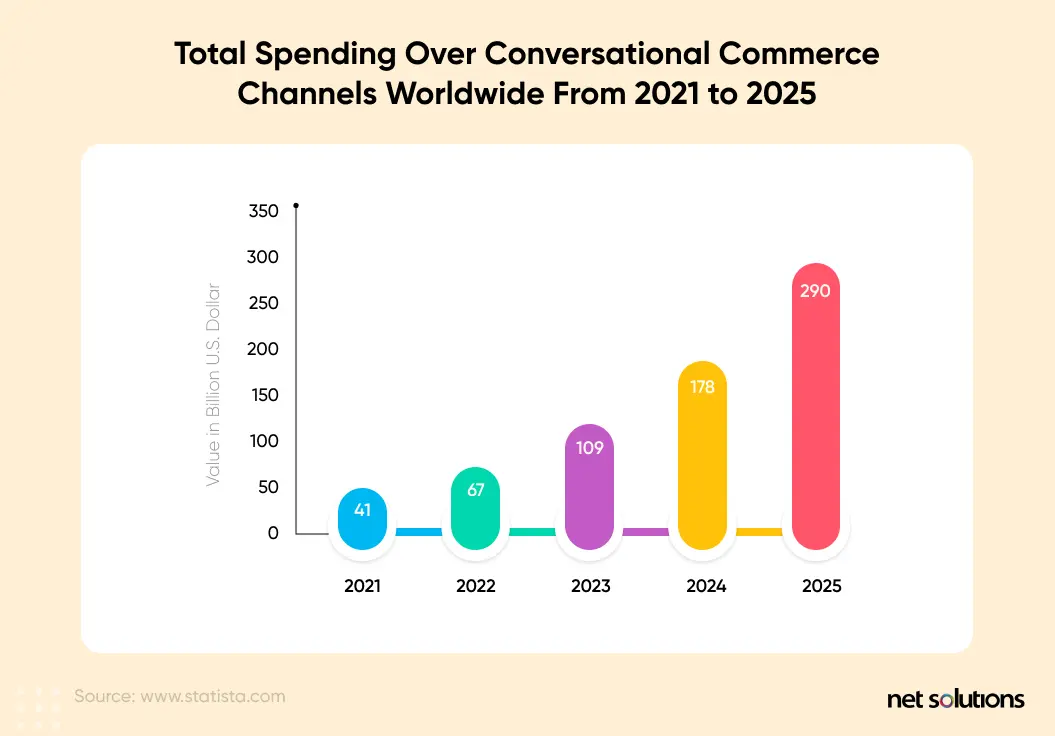
It is an effective way to boost sales. Many customers want immediate, real-time assistance, and by meeting their needs, you can improve your conversion rates by up to 82%.
While AI tools have added quality to understanding consumer behavior, Generative AI has added major impetus by offering actionable insights into real-time data. It becomes the game changer for eCommerce systems to ensure personalized (read that as “hyper-personalized”) customer experiences at every touchpoint. Combining GenAI and conversational commerce enables tailored, cohesive omnichannel experiences that enhance customer engagement. It takes eCommerce beyond simple transactions and elevates the entire experience.
Retailers can leverage AI-powered conversational commerce techniques, such as chatbots and voice assistants, to
- Engage customers through customized experiences.
- Recommend products based on preferences and purchase history via email messaging apps or popular chatbot assistants like Amazon Echo or Google Home.
- Boost sales by providing recommendations, promotions, and attractive deals & offers to customers.
- Collect customer data and real-time feedback for decision-making.
- Reduce service costs by offering pre-emptive and timely support through AI-powered chatbots.
- Minimize wait time through AI-powered chatbots that deliver efficient support.
- Automate handling of numerous customer inquiries through a live agent system to lower customer care expenses.
Incorporating these techniques enhances the overall customer experience and allows retailers to optimize their operations effectively while building stronger customer relationships.
eCommerce and Generation AI together mark a transformation for retailers aiming to deliver highly personalized omnichannel experiences. By anticipating and understanding customers’ needs, businesses can strengthen customer loyalty, drive growth, and exceed their expectations.
MACH architecture
MACH architecture is a modern software architecture style adopted by many retailers and digital experience platforms. It lets you build composable solutions using the best tools in the market. Also, each component in MACH is pluggable, scalable, replaceable, and can be continuously improved, which means you can add, replace, or remove those tools in the future if your demands evolve.
The MACH architecture consists of the following four key components:
- Microservices: MACH architecture breaks down the traditional monolithic eCommerce platform into small, independent microservices – making development, deployment, and scaling easier.
- API-first: MACH architecture is API-first, meaning the microservices are exposed through APIs. As a result, you can easily integrate the platform with other systems, such as CRM and marketing automation.
- Cloud-native: MACH architecture is cloud-native, which means it is designed to take advantage of the scalability and resilience of cloud computing platforms. Hence, scaling the platform and recovering from outages becomes easier and more cost-effective.
- Headless: MACH architecture is headless, meaning the front-end presentation layer is decoupled from the back-end commerce functionality. Therefore, content delivery and experiences across multiple touchpoints, such as websites, mobile apps, and IoT devices, become more manageable.
There has been a significant growth in MACH adoption recently. According to Global Enterprise MACHified Research 2023, 87% of those who have increased MACH are more responsive and ahead of the competition.
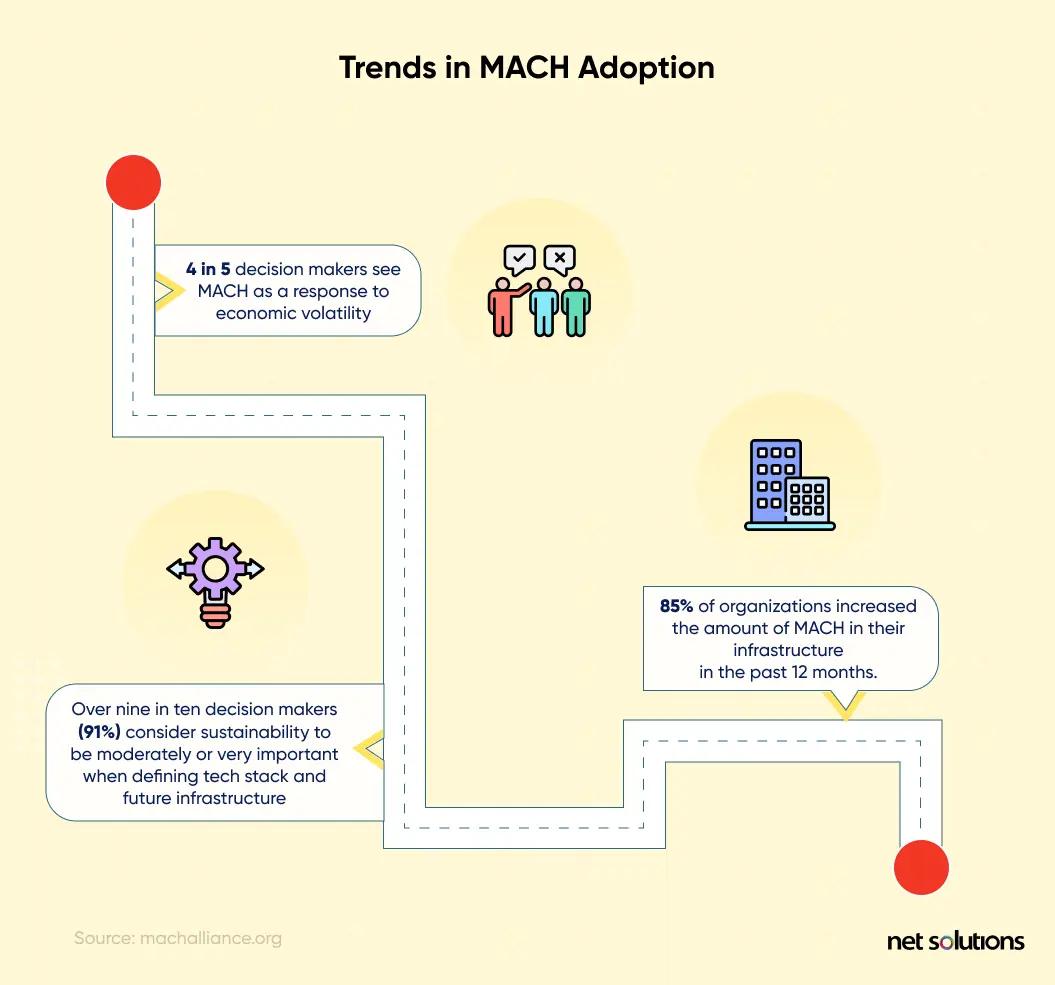
Source: MachAlliance
Here’s how MACH architecture can benefit if you’re a retail eCommerce owner:
- Faster time to market: MACH architecture makes it easy to develop and deploy new features, improving the time to market.
- Enhanced agility: MACH architecture makes it easier to adapt to market changes, helping retailers stay ahead of the competition.
- Improved scalability: MACH architecture is scalable, meaning you can quickly scale the platform up or down as needed.
Here are a few real-life examples of MACH architecture you can learn from:
- Uber, a ride-sharing platform, shifted to the MACH architecture to better support its eCommerce platform (what customers see) and dispatch library (what drivers see). All the services on the platform (Passenger management, driver management, passenger web UI, driver web UI, payments, trip management, and notifications) are interconnected via APIs.
- Amazon has been a strong promoter of the MACH architecture since its implementation in 2006. Amazon Web Services (AWS) has joined the MACH alliance to support the advancement of modern architecture for digital experiences. It offers many services to help retailers adopt a MACH architecture.
For example, AWS Lambda can run microservices, AWS API Gateway can create API-first applications, and AWS ECS (Elastic Container Service) can manage containers.
- eBay migrated to the MACH architecture after it felt that the traditional monolithic architecture limited its business growth. Today, it manages over a thousand services in different programming languages. Each service is managed by an independent team, making it easy for them to add new features and upgrades.
Composable commerce
By 2024, the mantra for new SaaS will be “composable API-first and API-only,” relegating traditional SaaS vendors as “legacy.”
– Gartner
Composable commerce focuses on assembling and integrating best-of-breed commerce capabilities from various vendors, such as shopping carts, payment gateways, inventory management systems, and content management systems, to create a customized commerce stack. As a result, you can
- Gain flexibility and agility, as they can easily replace or upgrade individual components without disrupting the entire commerce ecosystem.
- Seamlessly integrate the website with third-party services such as marketing automation tools, analytics platforms, or personalization engines, allowing retailers to leverage the latest technologies and optimize their operations.
- Create unique customer experiences by tailoring the commerce stack to specific requirements and quickly adapting to changing market requirements.
Composable commerce represents a paradigm shift in the eCommerce landscape like no other. Many C-suite executives are saying yes to composable, as 85% of businesses and technology leaders believe they must deliver improvements to customers quickly.
We are using composable architecture for one of our clients, a leading confectionery wholesaler in the UK, to ensure scalability and high performance. We use Contentful as the CMS, Algonomy as the search and product recommendation API, NextJS framework on the front end, and PHP Magento on the back end.
Personalized shopping experiences
49% of consumers say they will become repeat buyers after a personalized shopping experience with a retailer.
The rise of eCommerce has changed how people shop. They don’t just want to buy high-quality products from retailers but are also looking for personalized shopping experiences. The image below explains how necessary personalization actions are for consumers purchasing for the first time:
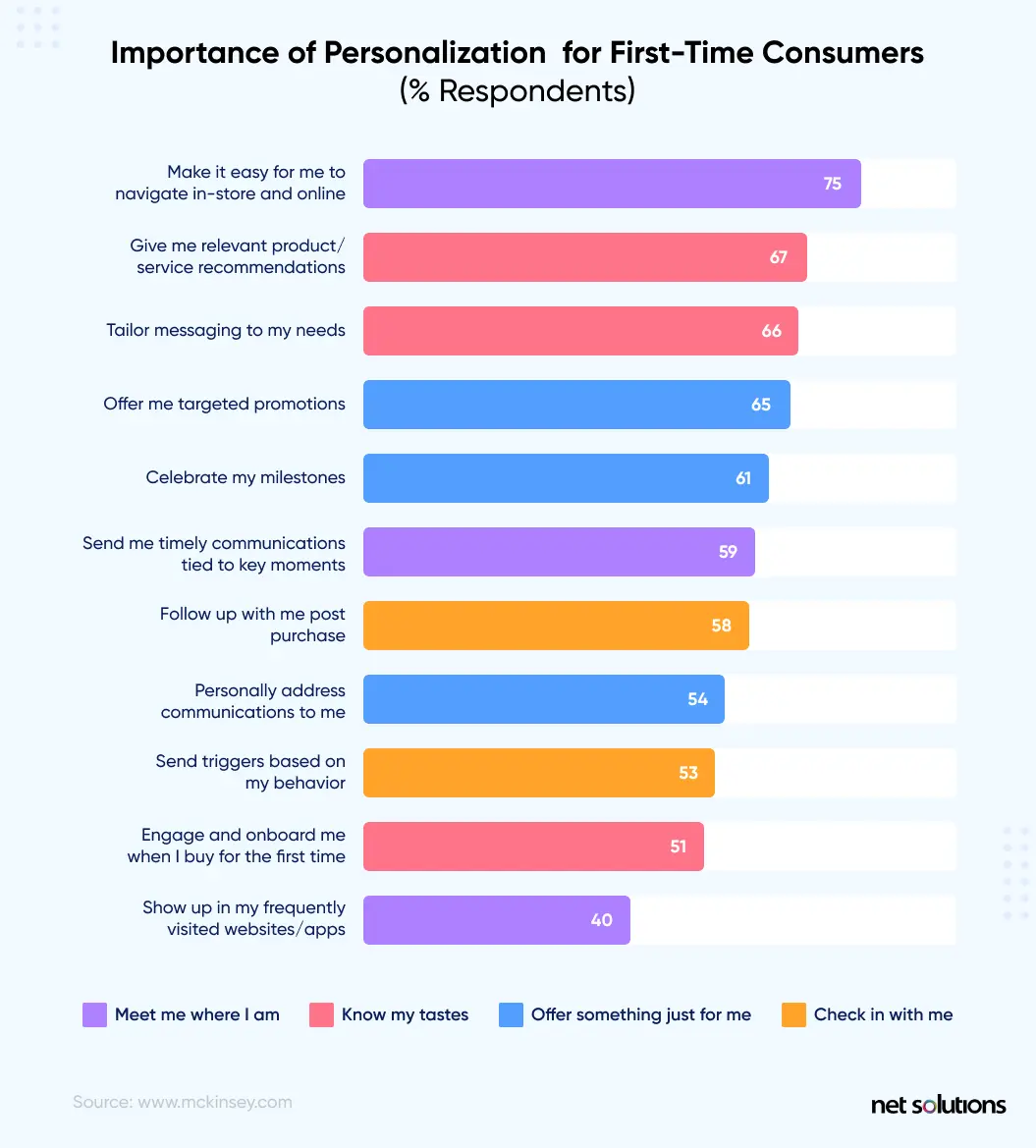
Source: McKinsey
Offering personalized shopping experiences leads to positive customer experience, essential for a retailer’s success. According to McKinsey, a positive customer experience can lead to
- 20% higher customer satisfaction rate,
- 10-15% boost in sales-conversion rates
- 20-30% increase in employee engagement
Personalization can also be a great revenue accelerator. Per McKinsey’s Next in Personalization Survey, companies that capture more value from personalization earn 40% more revenue. Besides, they experience better customer retention and increased customer loyalty.
There are so many oppurtunities on the horizon, from mobile exclusives to geo-located offers to better filtering and searching. We’ve only scratched the surface of what’s possible with personlization
– Michelle Peluso, Nike Board of Directors Member
Here are a few ways to leverage personalized shopping experiences on your eCommerce website:
- Offer product recommendations and exclusive offers tailored to each customer’s journey.
- Make customers’ shopping experience seamless by helping them easily find products they’re looking for and offering quick support if they face any issues.
- Offer multiple payment methods, such as Credit/Debit card payments, Google Pay, Apple Pay, or Klarna (a buy now, pay later service), to ensure customers always find their preferred method of payment.
Omnichannel customer experience
Omnichannel customer experience is no longer an afterthought for retailers but a requirement for survival. Consumers these days don’t even want to think in terms of traditional channel boundaries. Instead, they evaluate retailers and brands on the seamlessness of their shopping experience.
Hence, omnichannel customer experience should be your top priority this year as a retailer. Integrate all customer touchpoints into a cohesive experience so that customers can move seamlessly between channels without repeating steps or providing the same information multiple times.
“Winning in an omnichannel world demands excelling in all channels, from in-person to hybrid, inside sales, digital self-serve, and marketplaces—especially during uncertain economic times in which a poor customer experience may lead to a lost sale.”
– McKinsey
Here are a few real-life use cases of omnichannel customer experience for retailers:
- Save the sale allows customers to complete a purchase in a different channel from where they started shopping. For example, a customer might start browsing for a product on a retailer’s website and then decide to complete their purchase in-store.
- Endless Aisle allows customers to access a retailer’s product catalog through in-store kiosks or mobile apps, including out-of-stock or online-exclusive items.
- Local discovery leverages location-based technologies to provide customers personalized recommendations and promotions based on proximity to physical stores.
- Click & Collect allows customers to purchase products online and pick them up at a nearby store, enhancing convenience and reducing delivery times.
- Cataloging means providing digital product catalogs that customers can browse and interact with on various platforms.
Here are some tips for successfully implementing an omnichannel customer experience strategy:
- Start mapping customer touchpoints to spot customer experience gaps and identify improvement areas.
- Invest in technology that helps integrate customer touchpoints, such as a customer relationship management (CRM) system or a customer service platform.
- Train your employees on the importance of omnichannel customer experience and ensure they understand how to provide a seamless experience across all channels.
- Measure results and adjust as needed. You can create the desired impact only if you actively track the performance of your omnichannel customer experience strategy.
Subscription eCommerce
Subscription eCommerce models have gained significant popularity in recent years. The global subscription eCommerce market was $119.4 billion in 2022 and is expected to reach $1482.11 in 2027, growing at a CAGR of 65.8%.
Retailers see subscription eCommerce models as a means to steady, predictable revenue with a loyal customer base. In contrast, customers see them as a great convenience and a way to save money.
Here are various types of subscription eCommerce, along with their real-life use cases:
- Subscription bundles
Two or more subscription services offered at a discounted price are called subscription bundles. They’re a popular way for clients to save money. You can offer them to customers to increase customer loyalty and average order value.
Real-life examples of subscription bundles are:
- Internet providers like Vodafone and Virgin Mobile offer an opportunity to add Netflix or Apple TV+ at a discounted price.
- Amazon offers a subscription to Amazon Music and Amazon Prime at a discounted price.
- Microsoft offers subscriptions to six services (Word, Excel, PowerPoint, Microsoft Defender, OneDrive, Outlook) in one under Microsoft 365 for Home.
- Subscription marketplaces
Subscription marketplaces are platforms hosting multiple subscription-based retailers. Users can search, compare, and choose from various subscriptions on them. For retailers like you, subscription marketplaces can be a great way to reach a wider audience and foster customer loyalty by offering a more convenient shopping experience.
Here are the real-life use cases of subscription marketplaces:
- FabFitFun is a subscription marketplace that offers a variety of beauty, fashion, and lifestyle products. Customers can choose from a variety of boxes each season, and they can also add additional products.
- Thrive Market is a subscription marketplace that offers a variety of healthy and organic products delivered right to the customer’s door. Subscribers can save up to 50% on products and get free shipping on orders over $49.
- Replenishment subscription
Also called consumables subscription or subscribe and save model, replenishment subscription allows consumers to buy groceries, food items, medicines, and health supplements on a subscription basis. This way, consumers don’t have to place orders repeatedly; retailers like you get a steady income.
One of the most famous real-life use cases of replenishment subscriptions is Amazon Fresh, which lets you buy fresh vegetables and groceries weekly after you subscribe.
- Subscription bundles
Live streaming commerce
Live streaming commerce has become a mainstream eCommerce trend in China and is showing strong signs of growth in the US, UK, and France. According to Statista research, it would account for 10-20% of all eCommerce sales.
Here are the top five categories most purchased by live commerce in the last 12 months in China, Europe, Latin America, and the US:
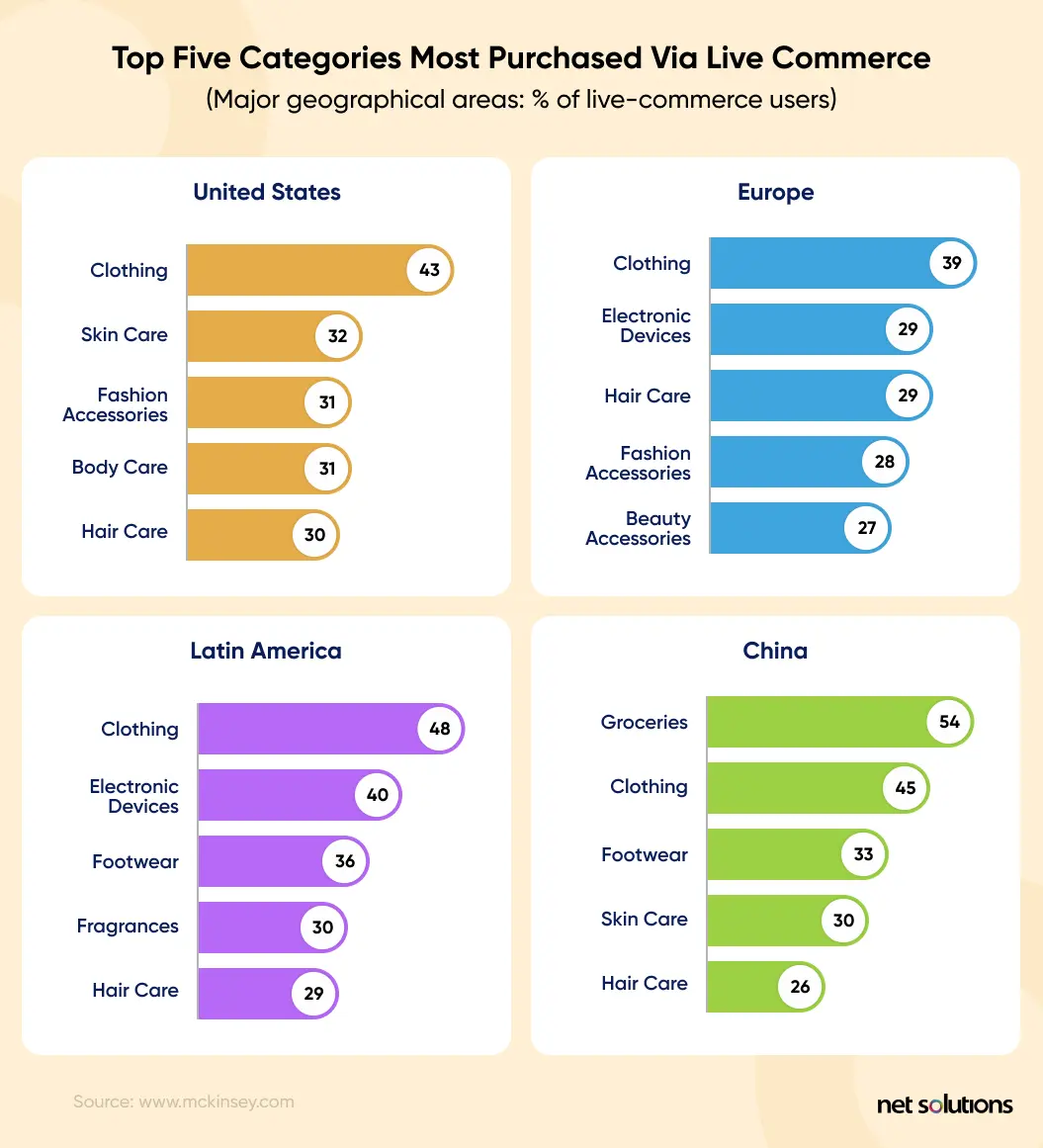
The following is a glimpse of how we categorize live commerce users by age groups in these regions:
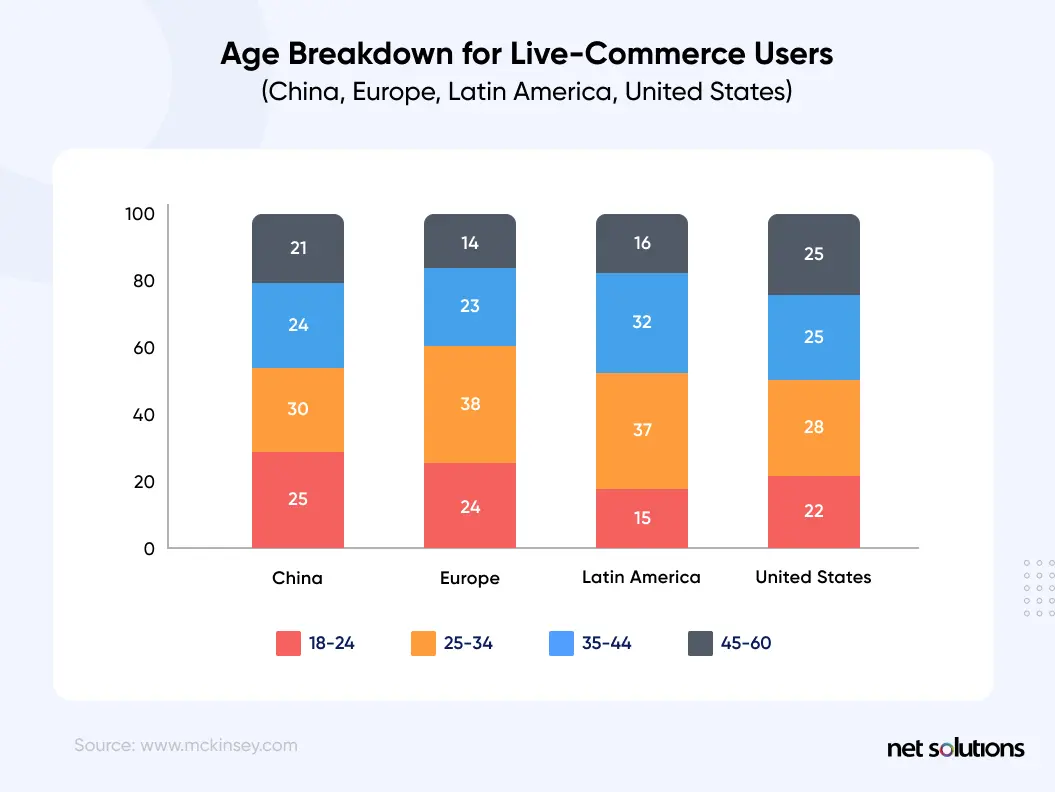
Live streaming commerce is soaring in popularity for the following reasons:
- With live-streaming commerce, retailers can connect with customers more personally. Also, the interaction is mutual, as customers can interact with live-stream hosts and ask questions about products. It builds trust and rapport.
- Live-streaming commerce is a highly effective way to market products. Retailers can use live streams to showcase products in action and give viewers tips and advice. It generates excitement and interest in products.
- Live-streaming commerce is also an efficient way to sell products, as retailers can sell products to customers directly, saving time and money on marketing and sales costs.
Real-life use cases of live commerce:
- Nordstrom launched a dedicated live shopping channel in 2021 that has hosted over a dozen live-streaming events with various themes like the best of all fashion, dressing for special occasions, and spring beauty trends. It has led them to boost their sales by offering an interactive shopping experience.
- Swedish makeup brand CAIA Cosmetics has also been using live-streaming commerce to entice customers since 2019. Live tutorials from its founder, Bianca Ingrosso, have garnered an average viewing time of 11 minutes. 60% of viewers like the content, while 11% interact on live chat.
- KitKat used live streaming commerce as part of its broader campaign to promote KitKat Chocolatory Australia. They hosted an event on Facebook Live that allowed shoppers to place orders via the “Comment to Message Feature.” The entire campaign succeeded, nearly generating one-third of KitKat’s annual sales.
Tips to use live-streaming commerce:
- Choose the right platform: Several live-streaming platforms are available. You must choose the one that is right for their consumers. Some popular platforms include Facebook Live, YouTube Live, and Instagram Live.
- Create engaging content: To keep viewers interested, live streams must be exciting and informative. You can achieve this by showcasing products, providing tips and advice, or interviewing experts.
- Promote live streams: Retailers must promote their live streams to attract viewers. Social media, email marketing, and paid advertising campaigns are all top outlets for promotion.
- Track results: It is essential to track the results of each live stream to see what is working and what is not. Metrics can include the number of views, sales, and engagement rate.
Digital wallets
A digital wallet, also called an e-wallet, is a device, online service, or software that enables individuals to engage in transactions by exchanging currency units for goods and services with another party. This can involve buying items using a computer or purchasing a smartphone at stores. It is a repository for copies of payment and identification cards such as credit cards, debit cards, membership cards, and driver’s licenses.
Digital wallets allow users to make payments in stores and utilize near-field communication (NFC) technology to communicate with payment terminals. Additionally, they offer the ability to store loyalty card details and digital coupons, simplifying the process of accessing and utilizing them when needed.
Digital wallets are also becoming increasingly popular as a convenient and secure payment method. According to Statista research, 49% of online transactions worldwide happened on digital wallets in 2022. By 2026, the number would increase to 54%.
Here’s why many consumers prefer digital wallets over other modes of payment:
- Security: Consumers can digitally store payment information, like credit card or bank account details.
- Quick, hassle-free payments: Making payments during online purchases is quick and hassle-free with digital wallets, as consumers don’t have to manually enter payment details for every purchase.
Integrating popular digital wallets like Apple Pay, Google Pay, and Amazon Pay into your website can save customers’ time and reduce friction in the checkout process. It can also create opportunities to upsell and cross-sell.
For example, if a customer adds a three-piece suit to their cart on your website, you can send them a notification announcing 10% cashback on a pair of shoes if they also buy them using Apple, Google, or Amazon Pay. This way, the customer gets a pair of shoes at a discounted price if they’re interested in buying them, and you get to sell one more product.
To successfully integrate digital wallets into your website, you must understand two things:
- From which types of companies do they want digital wallets?
- What features or capabilities do they want in the digital wallets?
The following image from a McKinsey Digital Payments Survey answers both questions:
Voice commerce
Voice commerce, also known as voice-activated shopping, refers to voice recognition technology that enables users to make purchases or engage in commerce-related activities through voice commands. This is made possible by assistants and smart speakers, like Amazon Echo (featuring Alexa), Google Home (with Google Assistant), Apple HomePod (powered by Siri), and similar devices.
The process involves customers utilizing natural language voice commands to search for products, inquire about items, add products to their shopping cart, and complete purchases without interacting with a device. Voice commerce can also extend functionality to order management, shipment tracking, and customer service interactions.
Voice commerce
- offers convenience and accessibility
- allows users to shop hands-free
- proves useful for multitasking individuals or those with impairments or limited mobility
- provides a natural way for humans to interact with technology since speaking is an inherent means of communication.
The use of voice commerce is rising, and around 51% of shoppers use voice assistance to help them find the right products. Some real-life examples of voice commerce are:
- Replenishing household items: Many shoppers reorder household items using Alexa and Google Home when they run out of them.
- Grocery Shopping: Some shoppers use voice assistants to add grocery items to their cart and order later, as they find it more convenient than typing a long list on their phone.
- Making Impulse Purchases: Shoppers also use voice search to directly order products that pique their interest, such as a new book, a pair of sneakers, or a cup of coffee when they feel tired.
Many consumers even rely on smart speakers and voice assistants like Alexa and Siri for product recommendations, as it saves them time and is more convenient than searching them online.
Although, despite these promising use cases and the hype surrounding voice commerce, it hasn’t taken off as expected because of:
- Privacy concerns: Most customers are worried that the information they provide may fall into the wrong hands, making them target to unwanted marketing attempts, spam, and identity theft.
- Lack of integration with all banks and credit card companies: Not all banks or credit card companies allow purchases through voice commerce. As a result, consumers either have to resort to conventional eCommerce or switch to a bank that’s voice-commerce friendly – both of which are hassles.
- Adoption Issues: Gen-Z buyers find it natural to speak to a device, but older generations don’t feel comfortable in doing so. Also, they feel concerned that the AI assistant will not understand their command.
- Speech Recognition Issues: Despite supporting advanced natural language processing technology, AI assistants face difficulty understanding consumers due to various accents, varied speech cadences, and other aspects. As a result, they may process wrong orders, which can be costly and inconvenient for consumers.
- Lack of Visual Interface: Consumers, especially younger age groups, have no qualms about using voice commerce to buy low-priced commodities like flowers, books, and grocery items. But when it comes to big-ticket purchases like a car, a MacBook, or a boat – they need visual confirmation. 57% of consumers even say they would use voice commerce to buy low-priced goods and services.
Here’s how you can overcome these challenges and make the most out of voice commerce on your eCommerce store:
- Optimize your product information and content to be voice-search-friendly.
- Ensuring seamless integration on your website with voice assistant platforms.
- Offer secure authentication methods to prevent unauthorized purchases.
Visual search
Visual search is an AI-powered technology that lets consumers search for products using images instead of text. It uses a combination of computer vision and machine learning to provide relevant search results.
Here are a few real-life examples of visual search:
- Google Lens lets you click a picture of products you like on Instagram, a magazine, or on the street and find relevant suggestions.
- Pinterest Lens can help if you’re looking for style inspiration. All you need is to click a photo of your outfit, and the software will suggest complementary pieces to complete the look.
- The IKEA app lets you visualize furniture in your room using your phone’s camera before you buy it, reducing friction before purchase.
- L’Oreal Haircolor Advisor lets you try on different hair colors at home using AR technology before you hit the salon.
The advancements in technologies and rapid adoption of visual search engines (ViSE) in the eCommerce industry have escalated the growth of the visual search market. It is estimated to rise to $32,984 million by 2028, growing at a CAGR of 17.50% for 2021-2028.
Tech-savvy internet users have been using reverse-image searches for years on Google. However, many shoppers have recently shown interest in using visual search in retail shopping technology, as evidenced by the image below:
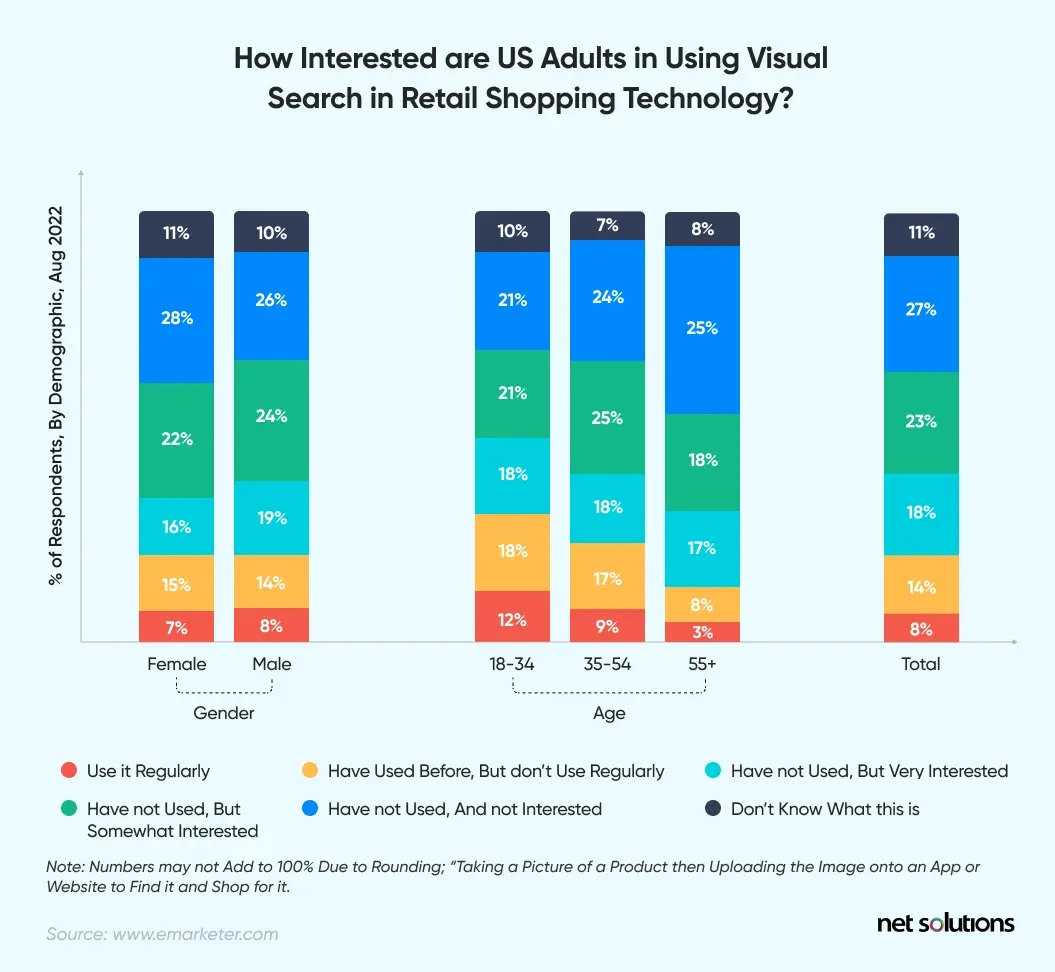
Visual search benefits retailers by
- Helping shoppers quickly find products they wish to buy, reducing friction, and increasing sales. Studies have shown that visual search leads to checkout twice as promptly as text-based search.
- Cutting through the noise of online shopping by making it easy for shoppers to decide.
Besides, tracing a sale back to a visual search is easy. Retailers can see when a shopper clicks on a visual search, what styles they searched, and when they purchased the item. This way, they can analyze which products are constantly searched and purchased via visual search.
To make the most out of visual search:
- Ensure that your products appear in the most used visual search engines. If you haven’t done so already, here are the steps you can take.
- Optimize your product images to ensure they rank high on visual search engines. Ensure they’re high-quality and follow Google Image SEO practices.
- Ensure you have a strong presence on Instagram, Pinterest, and other social media channels showcasing a rich catalog of product images.
You can also introduce visual search into your store natively. Some eCommerce platforms even offer visual search capabilities to embed on your website and mobile app. For example, Shopify has apps like Visual Search, and Magento offers Product Search Via Image Extension.
Buy Now, Pay Later (BNPL)
Sometimes, a customer likes a product but doesn’t buy it because they don’t have the budget. Many retailers have launched a Buy Now, Pay Later (BNPL) scheme to ensure they don’t miss out on such customers. It allows shoppers to pay for products in regular installments over time rather than spending it upfront.
39% of consumers prefer BNPL over credit card payments since BNPL agreements are typically interest-free. The scheme is trendy among the 34-44 age brackets, with 50.1% of consumers preferring it, followed by the 25-34 age group, with 48% of consumers choosing BNPL.
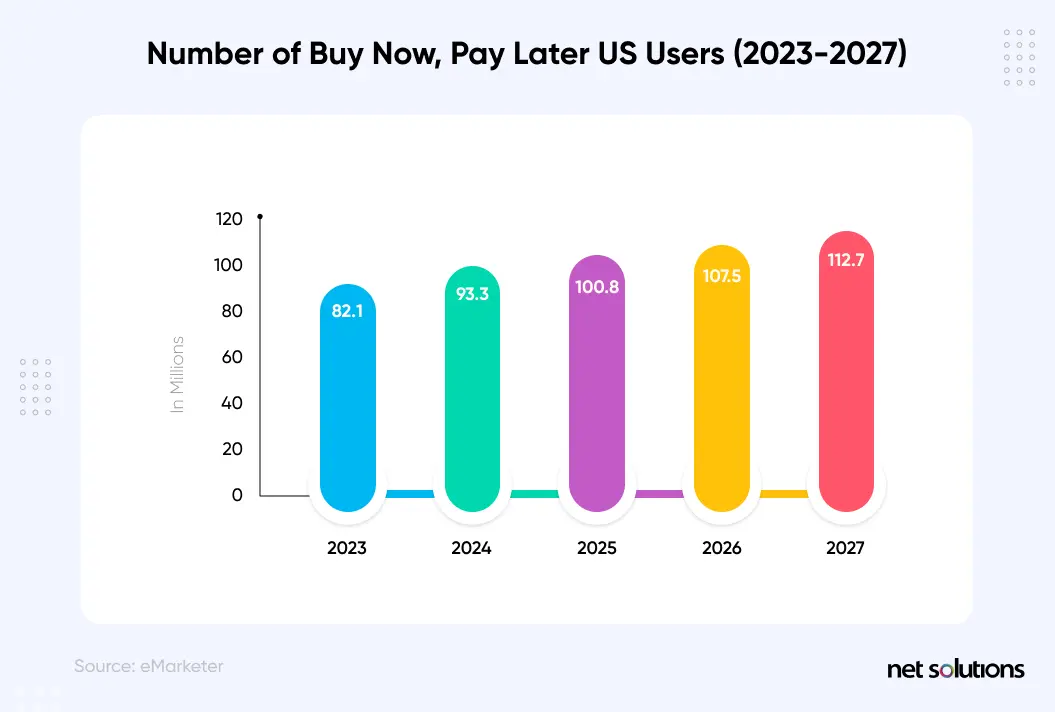
Popular platforms facilitating BNPL transactions are Klarna, Afterpay, Affirm, and Sezzle. Shopify also offers customers a BNPL plugin called Shop Pay Installments, thus eliminating the need to install a third-party BNPL on eCommerce websites built using Shopify. Even Mastercard has introduced Masterpay Installments—a Buy Now, Pay Later scheme for users who can’t afford to pay upfront for products.
Retailers are adopting the BNPL model because it
- Reduces cart abandonment rate,
- Boosts sales,
- Speeds up the checkout process,
- Increases order value size
Enhancing in-store experiences through BOPIS
Despite the rise of eCommerce, physical stores remain a critical touchpoint for customers. Enhancing in-store experiences involves leveraging cutting-edge technology and innovative strategies to create a seamless and engaging shopping environment.
One key aspect is the implementation of BOPIS (Buy Online, Pick Up In-Store) services. BOPIS allows customers to shop online and pick up their purchases at a nearby store, combining the convenience of online shopping with the immediacy of in-store pickup.
BOPIS also enables additional opportunities for upselling and cross-selling, as customers can easily compare different product options and upgrade to a higher model. For example, comparing both models in person can easily convince a customer who selected a basic smartphone online to upgrade to a higher model. Similarly, your staff can proactively suggest complementary products when customers pick up their orders from your store.
Other enhancements can include interactive digital displays, augmented reality (AR) or virtual reality (VR) experiences to try products virtually, and mobile point-of-sale systems to reduce checkout queues.
By integrating technology and creating memorable in-store experiences, retailers can differentiate themselves, attract customers, and foster loyalty in the increasingly competitive retail landscape.
“Customer service shouldn’t just be a department, it should be the entire company.”
– Tony Hsieh, CEO of Zappos
Adapt to an Ever-changing Industry with Net Solutions
eCommerce is forever evolving, and understanding the latest trends will help you stay ahead of the competition by integrating techniques that work best for your brand and business model. Monitor your competitors, observe the new practices, and prioritize changes impacting your bottom line.
Net Solutions has built strategic, shopper-first eCommerce platforms for over two decades, serving everything from small businesses to retail giants like Euro Car Parts (ECP), 2XU, and Legend Footwear.
Take ECP, for instance. ECP’s legacy eCommerce infrastructure meant that their current online store struggled to expand the online market. The infrastructure was not scalable enough to handle a volume of transactions simultaneously. They also faced challenges in maximizing their conversion rates and integrating platform components to update inventory and fulfillment procedures.
Euro Car Parts (ECP) hired Net Solutions to spearhead their digital transformation. This involved building new apps and refactoring old ones. Net Solutions’ API-first approach and capability of leveraging the power of cloud computing helped optimize ECP’s online presence. The transformation propelled them to the prestigious IRUK Top 500 rankings.
Net Solutions offers seamless eCommerce replatforming backed by 20+ years of multi-domain experience. Our expert teams align solutions with your goals, ensuring zero data loss or disruption to your operations. Embrace the future with a result-driven, scalable, feature-rich, and future-proof eCommerce solution and create an optimized website performance to exceed customer expectations.
Don’t let legacy systems hinder your growth. Upgrade, reinvent, and replatform with Net Solutions to stay at the forefront of the industry. Contact us if you’re looking to build a new eCommerce website or optimize your existing one – transform your online store!
SHARE THIS POST
Table of Contents
Related Resources
- eCommerce App Development Cost: Budgeting In-Depth Guide
- 13 Differences Between B2B and B2C eCommerce Websites
- Top 10 eCommerce Challenges and Easy Ways to Overcome Them
- 3 Types of eCommerce Business Models That Work in 2024
- eCommerce for Business: Is eCommerce Applicable for All Business Types
- eCommerce Customer Journey Mapping - The Secret to Higher Conversion Rates
- What is Headless Commerce? The Ultimate Guide
- Top 15 eCommerce KPIs to Track the Performance of Your Online Business
- Why Your Business Needs a Mobile eCommerce App
- Omnichannel Retail Strategy: A Comprehensive Guide
- Omnichannel vs Multichannel Retailing: The Complete Guide
- What is eCommerce Order Fulfilment? (And 6 Steps to Improve the Process)
- PCI Compliance: Everything You Need To Know
- The BEST Guide to eCommerce Personalization
- 12 Essential Factors for Choosing the Best eCommerce Platform
- The Ultimate Guide to Product Information Management (PIM) Systems for Ecommerce
- What is a Product Recommendation Engine (And How it Helps Boost Sales)
- eCommerce Replatforming: Challenges, Benefits, and Best Practices
- The Ultimate Guide to eCommerce Security
- How Voice Search will Transform the Future of eCommerce
- What is Web Accessibility (And Why it Matters for Your eCommerce Business)

